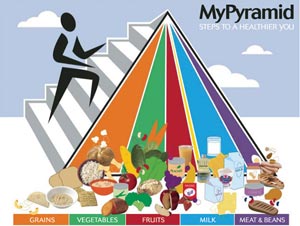 In 2005 the US Department of Agriculture’s Center for Nutrition Policy and Promotion made major changes to the Food Guide Pyramid. Vertical stripes replaced the building blocks to help represent moderation by the narrowing of each group from bottom to top, proportionality by the different widths of the stripes, variety by the new colors introduced, and the importance of physical activity and gradual improvement through the steps and slogan “Steps to a Healthier You”.
In 2005 the US Department of Agriculture’s Center for Nutrition Policy and Promotion made major changes to the Food Guide Pyramid. Vertical stripes replaced the building blocks to help represent moderation by the narrowing of each group from bottom to top, proportionality by the different widths of the stripes, variety by the new colors introduced, and the importance of physical activity and gradual improvement through the steps and slogan “Steps to a Healthier You”.
Recently, the USDA released new dietary guidelines for 2025, but the changes aren’t nearly as drastic. As Kelly said so well, “While it may be surprising that not much has changed since 2005 when our health obviously has, the new 2025 Dietary Guidelines show that how to eat healthy hasn’t changed, we just need to follow the guidelines now more than ever.” So just how do you follow the Dietary Guidelines for health and even weight loss? I have been teaching clients how to do this for the last five years with the help of the USDA and MyPyramid.gov.
First, determine how many calories you need each day based on your age, gender, and activity level. If you are trying to gain weight, you would increase this slightly. If you are trying to lose weight, you would decrease slightly and/or add more activity. In addition, MyPyramid breaks down how much of each food group that you need based on specific caloric intakes. You can also your stats for a personalized MyPyramid Plan.
A sample menu is provided to get you started. You can start here and adjust to your specific caloric needs with the Menu Planner, a nice interactive tool that lets you visualize how different meals and foods will help you reach your nutritional needs.
The MyPyramid Tracker gives you a way to track your nutritional and physical activity habits daily, so you can see where you need to make improvements and where you have made improvements. The sample diet is broken down into three meals and a snack because you will have more consistent energy (rather than peaks and drops) if you eat more small meals throughout the day, spreading out the calories and keeping your metabolism going at all times, which can also encourage weight loss.
Moderation is a key feature of this revised food pyramid. The narrowing of the bands of color illustrate an avoidance of foods with solid fats and added sugars. The more processed food has been the more that has been added to it and the less nutritional it becomes. Fresh fruits and vegetables may be more expensive, but they are always better for you. My experience is that you feel more full eating simpler, healthier food.
The ideas may not be new, but I encourage you to check out the resources at MyPyramid.gov to see how well you are truly meeting dietary recommendations. Rather than fads and restriction, this is a balanced way to approach nutrition and weight loss.
